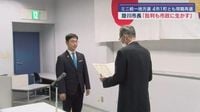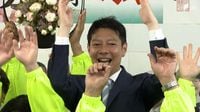In a remarkable display of support for incumbents, the recent unified local elections held across four cities and one town in Shizuoka Prefecture resulted in all existing mayors being re-elected. This outcome underscores the confidence voters have in their current leaders and the initiatives they have undertaken.
The most notable victory came from Hiroaki Kusachi, the mayor of Makinohara City, who secured his second term with a resounding margin. Kusachi garnered 57,577 votes, significantly outpacing newcomer Ken Kashiwagi, who received just 14,470 votes. Kusachi’s win was characterized by nearly four times the votes of his opponent, indicating a strong endorsement from the community.
"I want to advance the work I have done over the past four years and move forward with all my strength to create a safe town with further appealing charm," Kusachi stated after his victory. His campaign focused on making Makinohara an exciting place for younger generations while ensuring safety through robust disaster prevention measures and infrastructure maintenance.
In Kakegawa City, Takashi Hisakubota also achieved a decisive victory, re-elected with more than double the votes of his challenger. Hisakubota expressed gratitude for the support he received during the campaign, noting that he had heard various opinions, encouragement, and criticisms from citizens. "I want to use these insights to enhance municipal administration in the future," he remarked, highlighting his commitment to community engagement.
Meanwhile, in Izunokuni City, incumbent mayor Masayuki Yamashita was re-elected without opposition. At 69 years old, Yamashita aims to address pressing issues such as the declining birthrate and an aging population. "We need to create a sustainable community where everyone feels happy and safe," he emphasized, reflecting on the challenges facing the region.
In Nishiizu Town, Kiyohiko Hoshino secured his third term without facing any challengers. Hoshino, aged 47, plans to focus on disaster prevention strategies, improve the child-rearing environment, and promote the relocation of young people to the area. His commitment includes developing tsunami evacuation towers to enhance safety for residents.
Similarly, Noriyuki Ohba, 61, was re-elected in Minamiizu Town without opposition. His administration will continue to prioritize community welfare and safety, ensuring that residents feel secure and supported.
The voter turnout across the elections varied, with Makinohara City recording a turnout of 55.70%. This figure was noted to be 3.52 percentage points lower than the previous election held eight years ago, indicating a slight decline in voter engagement.
The results of these elections reflect a broader trend in local governance, where incumbents are often favored due to established relationships with constituents and a track record of service. Voters seem to appreciate continuity in leadership, especially in times of uncertainty.
As these mayors embark on their new terms, they are faced with the challenge of addressing ongoing community concerns while also looking towards future development. The focus on safety, community engagement, and sustainable practices will likely shape their agendas in the coming years.
Overall, the recent local elections in Shizuoka Prefecture highlight the importance of local governance and the role of elected officials in fostering community well-being. As these leaders take the helm once again, their commitment to building safer, more vibrant towns will be crucial for the future of their communities.





